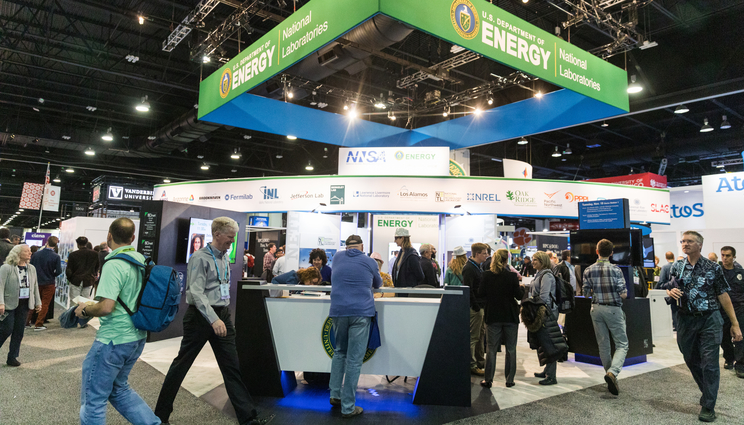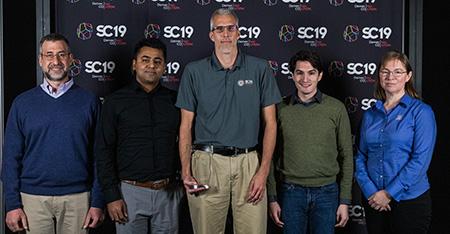LLNL’s presence in HPC shines bright at SC19
 (Download Image)
(Download Image)
The Department of Energy’s booth at the 2019 International Conference for High Performance Computing, Networking, Storage and Analysis (SC19) showcased the wide range of computational research being performed at each of DOE’s 17 national laboratories, including Lawrence Livermore National Laboratory’s work using Sierra for National Ignition Facility and inertial confinement fusion (ICF) research, as well as exascale computing. The booth also featured a talk by LLNL computer scientist Brian Spears on cognitive simulation, and recruiting efforts spearheaded by LLNL computer scientist Jean Shuler and more than a dozen LLNL attendees, drawing a steady stream of visitors and job applicants eager to hear about the Lab’s mission and work opportunities. Photo courtesy of SC19 Photography.
The 2019 International Conference for High Performance Computing, Networking, Storage, and Analysis— better known simply as SC19 — returned to Denver, and once again Lawrence Livermore National Laboratory (LLNL) made its presence known as a force in supercomputing.
The conference, attended by nearly 14,000 people representing 118 countries, kicked off with all-day tutorials and workshops on Nov. 17. Livermore Computing’s Chief Technical Officer Bronis de Supinski led a tutorial on mastering the tasking concept on OpenMP, computer scientists Cyrus Harrison and Matt Larsen conducted a tutorial on in-situ processing tools, and computer scientist Ignacio Laguna participated in a tutorial on tools to analyze floating-point scientific software.
The day was punctuated by the Fifth Computational Approaches to Cancer workshop, featuring Lab scientists Amanda Minnich, Peer-Timo Bremer, Derek Jones and Stewart He, along with researchers from the National Cancer Institute, Duke University and Argonne and Oak Ridge national laboratories, to name a few. During the all-day event, researchers presented updates on the Accelerating Therapeutics for Opportunities in Medicine (ATOM) consortium — a project involving LLNL that seeks to speed up discovery of new cancer drugs — as well as LLNL’s work on modeling drug molecules in the human body. Bremer presented the LLNL-led Pilot 2 project for the Joint Design for Advanced Computing Solutions for Cancer (JDACS4C), a collaboration between the Department of Energy (DOE) and National Cancer Institute (NCI). The project, co-led by LLNL’s Chief Computational Scientist Fred Streitz out of DOE’s Artificial Intelligence and Technology Office, is focused on simulating the molecular interactions and dynamics of RAS proteins, whose mutations are tied to about a third of human cancers.
Miles from the Colorado Convention Center, at a nearby art gallery, LLNL physicist Brian Spears participated in a Q&A session as part of HPC Day, an event presented by the publication The Next Platform. During his interview, Spears discussed the Lab’s integration of artificial intelligence (AI) into its scientific workload, particularly with inertial confinement fusion (ICF) research, where AI and cognitive simulation are being used to improve the predictive models of ICF reactions.
On the morning of Nov. 18, all eyes were on the release of the TOP500 List of the world’s most powerful computers. The top 10 fastest HPC systems remained unchanged from the previous list in June, with LLNL’s Sierra holding on to the No. 2 spot behind Oak Ridge National Laboratory’s Summit. Lassen, Sierra’s unclassified companion system, again placed No. 10 on the list. In all, nine LLNL high performance computing systems made the TOP500, including a new computing cluster scheduled for delivery in December called Magma. Magma, a Penguin Computing/Intel system that will serve the National Nuclear Security Administration’s (NNSA) Advanced Simulation and Computing program, debuted at No. 69.
While the hardware grabbed the headlines, LLNL Computing staff were extremely active in all-day tutorials and workshops. Computer scientists Todd Gamblin and Greg Becker tutored attendees on Spack, the R&D100 award-winning package manager for HPC machines. Gamblin said Spack is now being used worldwide and on seven of the top 10 supercomputers. LLNL Data Analysis Group Leader Kathryn Mohror led a workshop on how to create and deliver effective research posters, Lab systems software developer Elsa Gonsiorowski counseled students on how to deal with HPC software challenges and Laguna participated in a workshop on correcting software for HPC applications. The day ended with the “HPC Is Now” plenary featuring futurist Eric Hunter, cybersecurity expert Erin Kenneally and information security specialist Ben Rothke on the ethical questions around automation, particularly in cases when software fails and causes damage, injuries or loss of life.
A multi-institutional team led by Lawrence Livermore National Laboratory computer scientists (starting second from left) Harsh Bhatia, Peer-Timo Bremer and lead author Francesco di Natale won the prestigious SC19 award for Best Paper for their work in creating a multi-scale framework using machine learning to simulate the molecular interactions and dynamics of RAS proteins, whose mutations are tied to about a third of human cancers. The researchers are flanked by SC19 Papers Chairs Scott Pakin of Los Alamos National Laboratory (far left) and Michelle Mills Strout of the University of Arizona. Photo courtesy of SC Photography.The conference’s massive exhibition floor was open for business on day three, featuring a total of 374 exhibitors in the tech industry, academia and government. The DOE booth showcased the broad range of computational research being performed at each of its 17 national laboratories, with LLNL’s presence focused on using Sierra for the National Ignition Facility and ICF research, as well as exascale computing.
Cornell University planetary scientist Steve Squyers delivered the morning’s keynote address on using computation and engineering to overcome the numerous logistical challenges he and his team faced as principal investigator on NASA’s Mars Exploration Rover Missions, Spirit and Opportunity. The day continued with former LLNL Computing intern Nikoli Dryden presenting a paper including co-authors Brian van Essen, Tom Benson, Naoya Maruyama and Tim Moon, on accelerating large-scale constitutional neural networks through algorithms that exploit parallelism. A DOE "birds-of-a-feather" presentation on the early advances made in quantum computing at the DOE national labs, including LLNL, drew an overflow crowd of curious attendees.
Computing’s Deputy Associate Director for Science and Technology Lori Diachin opened the HPC Impact Showcase as the event’s chair. The showcase, which stretched over three days, included a presentation on an Exxon Mobil collaboration with LLNL, using Sequoia to speed up and improve the modeling of oil reservoirs. The project has resulted in a dramatic reduction in the time needed to model multiple geologic scenarios, from 66 weeks down to eight weeks. Later that afternoon, computer scientist Ian Karlin presented a paper on the Center of Excellence co-design effort with IBM to prepare codes for Sierra.
“Sierra was a major shift for Livermore,” Karlin said. “We wanted to hit the ground running.”
Highlighting day three of the conference at the DOE booth was a talk by LLNL’s Spears on the ways the Lab is using cognitive simulation and machine learning to impact mission areas. Spears said AI and HPC are the “exoskeleton” of how the Lab handles its data, and that cognitive simulation, as evidenced through the application of a deep learning tool called Merlin on 100 million ICF simulations, is allowing scientists to understand the structure of data and improve the predictive models of ICF implosions.
“ICF is a perfect testbed for AI development,” Spears said. “We believe machine learning will allow us to use our full datasets to make our simulations more predictive. We are advancing the way we develop predictive models using large-scale scientific machine learning, and we’re driving these techniques into a wide range of missions.”
LLNL had a strong and active presence in the conference’s student and postdoctoral career fair, which ran for most of the day on Wednesday. Spearheaded by LLNL computer scientist and technical recruiter Jean Shuler, with support from more than a dozen attendees from LLNL, the Lab’s booth enjoyed a steady stream of visitors and job applicants eager to hear about the Lab’s mission and work opportunities.
Later at the DOE booth, HPCwire publisher Tom Tabor presented LLNL with the Editors and Readers’ Choice awards for Top Supercomputing Achievement of 2019 to LLNL in honor of the collaboration with computing company Cray Inc. to build El Capitan, the first exascale-class supercomputer for the NNSA. LLNL joined Argonne, Oak Ridge and Cray in winning the awards, which recognized the three contracts signed earlier in the year to usher in the nation’s first exascale supercomputers for DOE. De Supinski accepted the award on behalf of the Lab.
That afternoon, LLNL computer scientist Francesco Di Natale presented a paper entitled “Massively Parallel Infrastructure for Adaptive Multiscale Simulations: Modeling RAS Initiation Pathway for Cancer,” stemming from the Pilot 2 JDACS4C project. The paper describes the Multiscale Machine-Learned Modeling Infrastructure (MuMMI) behind a simulation capable of predictively modeling the dynamics of RAS proteins and their interactions with RAF proteins as well as lipids, the organic compounds that help make up cell membranes. The framework uses machine learning to identify areas of interest to “zoom in” and analyze on a molecular level. The development will likely improve RAS-related experiments performed at NCI/Frederick National Laboratory for Cancer Research (FNLCR).
As a cold snap swooped into Denver, bringing light snow on Nov. 21, the conference began to wind down. LLNL computational scientist Erik Draeger moderated a panel of Exascale Computing Project (ECP) principal investigators. The panel, which included LLNL computer scientist Tzanio Kolev, discussed challenges and strategies for porting applications to exascale-class supercomputers. Kolev heads the Center for Efficient Exascale Discretizations (CEED) project for the ECP, which aims to develop algorithms that will better take advantage of the future exascale hardware and provide a more user-friendly exascale software ecosystem.
Perhaps the most significant news for the Lab out of SC19 came near the close of the conference as the SC19 Paper committee awarded the LLNL-led, multi-institutional team behind the JDACS4C Pilot 2 project with its prestigious Best Paper award, recognizing lead author Di Natale and more than 20 researchers from institutions including Los Alamos, the NCI/FNLCR, Oak Ridge and IBM. The pilot project, which is entering its fourth year, is being funded by the NNSA’s Advanced Simulation and Computing program.
“I can’t begin to describe how happy I am for our team — it has been a lot of hard work, and to have it recognized at this level is just amazing,” said Di Natale following the awards presentation.
SC19 concluded on Nov. 22 with a light agenda, including the second annual workshop on Performance, Portability and Productivity in HPC chaired by LLNL computer scientist Rob Neely. The workshop included LLNL computer scientist Tom Scogland as a panelist.
The 2020 Supercomputing conference will be held in Atlanta.
Contact
 Jeremy Thomas
Jeremy Thomas
[email protected]
(925) 422-5539
Related Links
2019 International Conference for High Performance ComputingAccelerating Therapeutics for Opportunities in Medicine
National Cancer Institute
HPC Day
TOP500 List
Sierra Supercomputer
Lassen Supercomputer
Magma Supercomputer
Spack
Tags
HPC, Simulation, and Data ScienceComputing
HPC Innovation Center
Featured Articles








